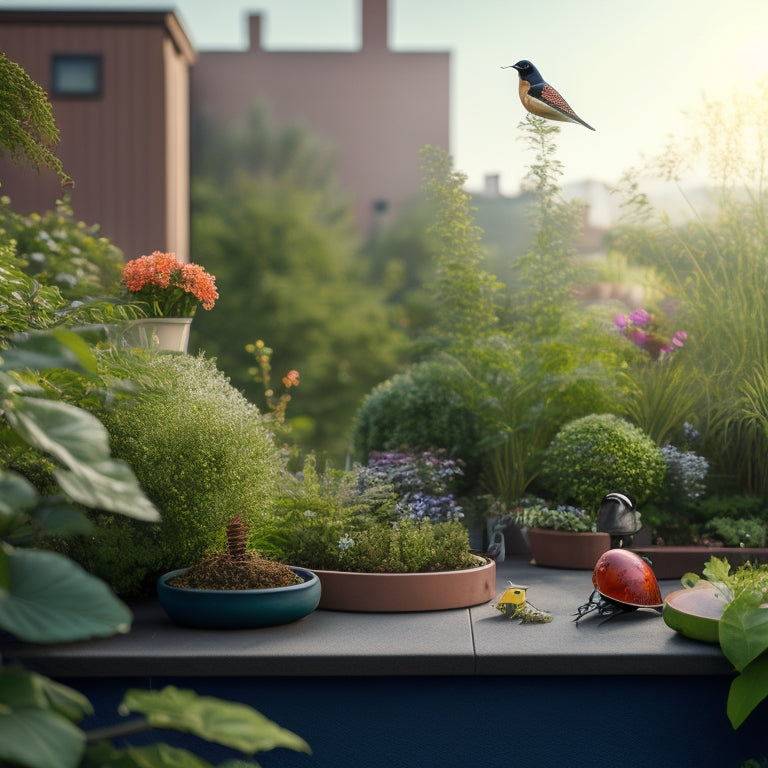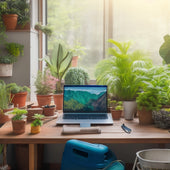
7 Rooftop Garden Pest Control Tips for Beginners
Share
To protect your rooftop garden from pesky pests, begin by identifying common culprits like aphids, whiteflies, and spider mites, which can wreak havoc on your plants. Regular inspections every 7-10 days can catch infestations early, so look for signs like holes in leaves, yellowing, or droopy stems. Use fine-mesh netting to block pests, and introduce beneficial insects or natural repellents to combat them. Practice good garden hygiene by removing debris and selecting pest-resistant plants. Pair plants strategically, set up traps, and monitor your garden closely. By following these initial steps, you'll be well on your way to a pest-free rooftop oasis, and there's more to explore in the world of rooftop garden pest control.
Key Takeaways
• Conduct regular inspections every 7-10 days to catch infestations early, focusing on areas like water sources, under leaves, and soil crevices.
• Use fine-mesh netting to block pests from accessing plants, securing it tightly with stakes or clips and burying edges to prevent burrowing.
• Introduce beneficial insects like ladybugs to prey on common pests, and utilize natural repellents like neem oil, garlic, and hot pepper sprays.
• Maintain good garden hygiene by regularly removing organic debris and dead plant matter, and ensuring soil health with organic matter like compost.
• Create a balanced ecosystem by using companion planting strategies, pairing plants to repel pests or attract beneficial insects, and monitoring for pest signs.
Identify Common Rooftop Pests
As you tend to your rooftop garden, you'll likely encounter a multitude of unwanted visitors, including aphids, whiteflies, and spider mites, which can quickly spread and wreak havoc on your carefully cultivated plants.
To effectively manage these pests, it's vital to develop pest identification techniques that allow you to recognize the subtle signs of infestation. Start by inspecting your plants closely, paying attention to any unusual markings, discoloration, or distortions.
Aphids, for instance, tend to congregate on new growth, leaving behind sticky honeydew droplets. Whiteflies, on the other hand, can be identified by their characteristic fluttering behavior when disturbed. Spider mites, often invisible to the naked eye, can be detected by the fine webbing they spin between leaves.
Understanding rooftop pest behaviors is important in anticipating and preventing infestations. By recognizing these signs and adapting your pest management strategies accordingly, you'll be better equipped to protect your rooftop garden from the devastating effects of pest infestations.
Inspect Your Rooftop Garden Regularly
Regular inspections of your rooftop garden, ideally conducted every 7-10 days, are essential in detecting pest infestations before they spiral out of control.
You'll want to keep a close eye on your plants, looking for signs of pest activity, such as holes in leaves, yellowing, or droopy stems.
As you inspect your garden, pay attention to areas where pests are most likely to congregate, such as near water sources, under leaves, or in soil crevices.
Keep in mind that pest behavior can change with seasonal changes, so be prepared to adapt your inspection routine accordingly. For instance, during warmer months, you may need to check for pests more frequently, as they tend to reproduce faster in these conditions.
Some key things to look out for during your inspections include:
-
Unusual plant growth patterns or discoloration
-
Actual pests or their eggs, larvae, or droppings
-
Weakened or damaged plant structures, such as holes or tears
Use Physical Barriers Effectively
By strategically placing physical barriers around your rooftop garden, you can effectively block pests from reaching your plants, thereby preventing infestations and reducing the need for pesticides.
One popular and effective barrier material is fine-mesh netting, which can be draped over individual plants or entire beds to keep pests out. When choosing netting solutions, consider the mesh size, material, and color to ascertain it's suitable for your plants and the pests you're targeting. For example, a 1/4-inch mesh netting can keep out whiteflies and aphids, while a 1/2-inch mesh can deter larger pests like rabbits.
To install netting effectively, stretch it tightly over the plants, securing it with stakes or clips. Make sure to bury the edges 2-3 inches deep to prevent pests from burrowing underneath.
You can also use other barrier materials like copper tape, which can deter slugs and snails, or fine-mesh row covers to protect entire rows of plants. By combining these physical barriers with regular inspections, you'll be well on your way to creating a pest-free rooftop garden.
Employ Organic Pest Control Methods
When targeting pests that have managed to bypass your physical barriers, turn to organic pest control methods that work in tandem with your rooftop garden's ecosystem, utilizing natural predators, parasites, and pathogens to regulate pest populations. These methods not only reduce the use of chemicals but also promote a balanced ecosystem.
You can introduce beneficial insects, such as ladybugs and lacewings, which prey on common pests like aphids and whiteflies. Another approach is to use natural repellents like neem oil, garlic, and hot pepper sprays to deter pests.
Additionally, you can:
-
Plant pest-repellent herbs like basil, mint, and lemongrass, which release chemicals that repel pests.
-
Use diatomaceous earth, a natural, non-toxic substance that dehydrates and kills pests.
-
Apply Bacillus thuringiensis (Bt), a bacterium that produces a toxin that kills certain pests.
Practice Good Garden Hygiene
Frequently, poor garden hygiene creates an environment conducive to pest infestations, so it's crucial that you maintain a clean and organized rooftop garden to prevent pest issues from arising in the first place. When you neglect to clean up debris, dead plant matter, and weeds, you're providing a habitat for pests to thrive.
Regularly remove any organic matter that's accumulated, and dispose of it properly to prevent the spread of disease. Additionally, verify your soil health is ideal by incorporating organic matter like compost, which will help promote a balanced ecosystem.
You should also focus on selecting pest-resistant plants that are well-suited to your rooftop garden's conditions. These plants will be more resilient to pest attacks, reducing the need for pesticides.
Moreover, maintain a tidy irrigation system to prevent waterlogged soil, which can attract pests. By practicing good garden hygiene, you'll create an environment that's less conducive to pest infestations, reducing the risk of damage to your rooftop garden.
Utilize Companion Planting Strategies
In your rooftop garden, strategically pair plants that repel pests or attract beneficial insects to create a balanced ecosystem, reducing the need for pesticides and promoting a healthy environment.
By doing so, you'll create a natural defense system that's both effective and sustainable. When selecting herbs for your rooftop garden, consider their pest-repelling properties and pair them accordingly. For instance, basil repels aphids and mites, while mint deters aphids and spider mites.
Here are some key considerations for companion planting:
-
Plant spacing: Verify that plants are spaced correctly to allow for proper air circulation and sunlight penetration, reducing the risk of fungal diseases and pest infestations.
-
Herb selection: Choose herbs that not only complement your desired plants but also provide pest-repelling benefits, such as basil, mint, and lemongrass.
-
Visual monitoring: Regularly inspect your plants for signs of pests or diseases, and adjust your companion planting strategy as needed.
Set Up Traps and Monitoring Systems
To further fortify your rooftop garden's defense against pests, you'll want to set up traps and monitoring systems that detect and capture unwanted visitors before they cause significant damage.
When it comes to trap placement, consider the type of pest you're targeting and the layout of your garden. For example, place sticky traps near areas where aphids or whiteflies tend to congregate, such as near plants with tender shoots or under leaves. Bait traps, on the other hand, can be placed near areas with high pest activity, like around plants with visible damage.
Effective monitoring techniques involve regularly inspecting your plants for signs of pest infestation, such as holes, discoloration, or actual pests. Use a hand lens or magnifying glass to examine leaves and stems closely.
You can also install monitoring systems like pheromone traps or pitfall traps to detect pests early on. By combining these approaches, you'll be able to identify pest issues quickly and respond promptly to prevent infestations from getting out of control.
Remember to adjust your trap placement and monitoring techniques as needed based on the changing pest landscape in your rooftop garden.
Frequently Asked Questions
Will Rooftop Pests Affect the Structure of My Building?
When you neglect pest identification, you risk structural damage to your building; undetected infestations can compromise its integrity, so it's essential you monitor for signs of pests and address issues promptly to prevent costly repairs.
How Often Should I Water My Rooftop Garden to Prevent Pests?
"You're wise to prioritize watering schedules for pest prevention. Consider the NYC High Line's drip irrigation system, which reduces moisture buildup and pest attraction. Aim for 1-2 inches of water per week, adjusting according to weather and soil type."
Can I Use Pesticides in My Rooftop Garden?
You shouldn't rely on pesticides in your rooftop garden, as they can harm beneficial insects and contaminate soil and water. Instead, explore pesticide alternatives and natural repellents, like neem oil, garlic sprays, and predator insects, to maintain a balanced ecosystem.
Are Rooftop Pests Attracted to Specific Colors or Lights?
As you gaze up at the stars, wondering if rooftop pests are drawn to neon signs, research reveals they're attracted to specific colors, like ultraviolet and yellow, and light attraction factors, such as intensity and wavelength, which you can manipulate to outsmart them.
Can I Have a Rooftop Garden if I Have a Small Rooftop Space?
You can thrive in small space gardening by leveraging container gardening techniques, strategically selecting compact plants, and optimizing vertical space to create a lush oasis, even on a petite rooftop.
Related Posts
-

How Much Do Concrete Planters Weigh
When creating a concrete planter, you'll need to take into account the weight implications of your design. The type a...
-

How Much Do Concrete Planters Weigh
When creating a concrete planter, you'll need to take into account the weight implications of your design. The type a...
-

How Much Do Concrete Planters Weigh
When creating a concrete planter, you'll need to take into account the weight implications of your design. The type a...
-

How Much Do Concrete Planters Weigh
When creating a concrete planter, you'll need to take into account the weight implications of your design. The type a...
-

How Much Do Concrete Planters Weigh
When creating a concrete planter, you'll need to take into account the weight implications of your design. The type a...
-

How Much Do Concrete Planters Weigh
When creating a concrete planter, you'll need to take into account the weight implications of your design. The type a...
-

How Much Do Concrete Planters Weigh
When creating a concrete planter, you'll need to take into account the weight implications of your design. The type a...
-

How Much Do Concrete Planters Weigh
When creating a concrete planter, you'll need to take into account the weight implications of your design. The type a...
-

How Much Do Concrete Planters Weigh
When creating a concrete planter, you'll need to take into account the weight implications of your design. The type a...
-

How Much Do Concrete Planters Weigh
When creating a concrete planter, you'll need to take into account the weight implications of your design. The type a...
-

How Much Do Concrete Planters Weigh
When creating a concrete planter, you'll need to take into account the weight implications of your design. The type a...
-

How Much Do Concrete Planters Weigh
When creating a concrete planter, you'll need to take into account the weight implications of your design. The type a...
-

How Much Do Concrete Planters Weigh
When creating a concrete planter, you'll need to take into account the weight implications of your design. The type a...
-

How Much Do Concrete Planters Weigh
When creating a concrete planter, you'll need to take into account the weight implications of your design. The type a...
-

How Much Do Concrete Planters Weigh
When creating a concrete planter, you'll need to take into account the weight implications of your design. The type a...
-

How Much Do Concrete Planters Weigh
When creating a concrete planter, you'll need to take into account the weight implications of your design. The type a...
-

How Much Do Concrete Planters Weigh
When creating a concrete planter, you'll need to take into account the weight implications of your design. The type a...
-

How Much Do Concrete Planters Weigh
When creating a concrete planter, you'll need to take into account the weight implications of your design. The type a...
-

How Much Do Concrete Planters Weigh
When creating a concrete planter, you'll need to take into account the weight implications of your design. The type a...
-

How Much Do Concrete Planters Weigh
When creating a concrete planter, you'll need to take into account the weight implications of your design. The type a...
-

How Much Do Concrete Planters Weigh
When creating a concrete planter, you'll need to take into account the weight implications of your design. The type a...
-

How Much Do Concrete Planters Weigh
When creating a concrete planter, you'll need to take into account the weight implications of your design. The type a...
-

How Much Do Concrete Planters Weigh
When creating a concrete planter, you'll need to take into account the weight implications of your design. The type a...
-

How Much Do Concrete Planters Weigh
When creating a concrete planter, you'll need to take into account the weight implications of your design. The type a...
-

How Much Do Concrete Planters Weigh
When creating a concrete planter, you'll need to take into account the weight implications of your design. The type a...
-

How Much Do Concrete Planters Weigh
When creating a concrete planter, you'll need to take into account the weight implications of your design. The type a...
-

How Much Do Concrete Planters Weigh
When creating a concrete planter, you'll need to take into account the weight implications of your design. The type a...
-

How Much Do Concrete Planters Weigh
When creating a concrete planter, you'll need to take into account the weight implications of your design. The type a...
-

How Much Do Concrete Planters Weigh
When creating a concrete planter, you'll need to take into account the weight implications of your design. The type a...
-

Selecting the Right Planter Dimensions for Your Space
When selecting the right planter dimensions for your space, you'll want to carefully consider the available area, mea...
-

Selecting the Right Planter Dimensions for Your Space
When selecting the right planter dimensions for your space, you'll want to carefully consider the available area, mea...
-

Selecting the Right Planter Dimensions for Your Space
When selecting the right planter dimensions for your space, you'll want to carefully consider the available area, mea...
-

Selecting the Right Planter Dimensions for Your Space
When selecting the right planter dimensions for your space, you'll want to carefully consider the available area, mea...
-

Selecting the Right Planter Dimensions for Your Space
When selecting the right planter dimensions for your space, you'll want to carefully consider the available area, mea...
-

Selecting the Right Planter Dimensions for Your Space
When selecting the right planter dimensions for your space, you'll want to carefully consider the available area, mea...
-

Selecting the Right Planter Dimensions for Your Space
When selecting the right planter dimensions for your space, you'll want to carefully consider the available area, mea...
-

Selecting the Right Planter Dimensions for Your Space
When selecting the right planter dimensions for your space, you'll want to carefully consider the available area, mea...
-

Selecting the Right Planter Dimensions for Your Space
When selecting the right planter dimensions for your space, you'll want to carefully consider the available area, mea...
-

Selecting the Right Planter Dimensions for Your Space
When selecting the right planter dimensions for your space, you'll want to carefully consider the available area, mea...
-

Selecting the Right Planter Dimensions for Your Space
When selecting the right planter dimensions for your space, you'll want to carefully consider the available area, mea...
-

Selecting the Right Planter Dimensions for Your Space
When selecting the right planter dimensions for your space, you'll want to carefully consider the available area, mea...
-

Selecting the Right Planter Dimensions for Your Space
When selecting the right planter dimensions for your space, you'll want to carefully consider the available area, mea...
-

Selecting the Right Planter Dimensions for Your Space
When selecting the right planter dimensions for your space, you'll want to carefully consider the available area, mea...
-

Selecting the Right Planter Dimensions for Your Space
When selecting the right planter dimensions for your space, you'll want to carefully consider the available area, mea...
-

Selecting the Right Planter Dimensions for Your Space
When selecting the right planter dimensions for your space, you'll want to carefully consider the available area, mea...
-

Selecting the Right Planter Dimensions for Your Space
When selecting the right planter dimensions for your space, you'll want to carefully consider the available area, mea...
-

Selecting the Right Planter Dimensions for Your Space
When selecting the right planter dimensions for your space, you'll want to carefully consider the available area, mea...
-

Selecting the Right Planter Dimensions for Your Space
When selecting the right planter dimensions for your space, you'll want to carefully consider the available area, mea...
-

Selecting the Right Planter Dimensions for Your Space
When selecting the right planter dimensions for your space, you'll want to carefully consider the available area, mea...
-

Selecting the Right Planter Dimensions for Your Space
When selecting the right planter dimensions for your space, you'll want to carefully consider the available area, mea...
-

Selecting the Right Planter Dimensions for Your Space
When selecting the right planter dimensions for your space, you'll want to carefully consider the available area, mea...
-

Selecting the Right Planter Dimensions for Your Space
When selecting the right planter dimensions for your space, you'll want to carefully consider the available area, mea...
-

Selecting the Right Planter Dimensions for Your Space
When selecting the right planter dimensions for your space, you'll want to carefully consider the available area, mea...
-

Selecting the Right Planter Dimensions for Your Space
When selecting the right planter dimensions for your space, you'll want to carefully consider the available area, mea...
-

Selecting the Right Planter Dimensions for Your Space
When selecting the right planter dimensions for your space, you'll want to carefully consider the available area, mea...
-

Selecting the Right Planter Dimensions for Your Space
When selecting the right planter dimensions for your space, you'll want to carefully consider the available area, mea...
-

Selecting the Right Planter Dimensions for Your Space
When selecting the right planter dimensions for your space, you'll want to carefully consider the available area, mea...
-

Selecting the Right Planter Dimensions for Your Space
When selecting the right planter dimensions for your space, you'll want to carefully consider the available area, mea...
-

Selecting the Right Planter Dimensions for Your Space
When selecting the right planter dimensions for your space, you'll want to carefully consider the available area, mea...
-

Selecting the Right Planter Dimensions for Your Space
When selecting the right planter dimensions for your space, you'll want to carefully consider the available area, mea...
-

Selecting the Right Planter Dimensions for Your Space
When selecting the right planter dimensions for your space, you'll want to carefully consider the available area, mea...
-

Selecting the Right Planter Dimensions for Your Space
When selecting the right planter dimensions for your space, you'll want to carefully consider the available area, mea...
-

Must-Have Tools for Building Block Planters Online
When building block planters online, you'll need essential tools to guarantee a sturdy and visually appealing structu...
-

Must-Have Tools for Building Block Planters Online
When building block planters online, you'll need essential tools to guarantee a sturdy and visually appealing structu...
-

Must-Have Tools for Building Block Planters Online
When building block planters online, you'll need essential tools to guarantee a sturdy and visually appealing structu...
-

Must-Have Tools for Building Block Planters Online
When building block planters online, you'll need essential tools to guarantee a sturdy and visually appealing structu...
-

Must-Have Tools for Building Block Planters Online
When building block planters online, you'll need essential tools to guarantee a sturdy and visually appealing structu...
-

Must-Have Tools for Building Block Planters Online
When building block planters online, you'll need essential tools to guarantee a sturdy and visually appealing structu...
-

Must-Have Tools for Building Block Planters Online
When building block planters online, you'll need essential tools to guarantee a sturdy and visually appealing structu...
-

Must-Have Tools for Building Block Planters Online
When building block planters online, you'll need essential tools to guarantee a sturdy and visually appealing structu...
-

Must-Have Tools for Building Block Planters Online
When building block planters online, you'll need essential tools to guarantee a sturdy and visually appealing structu...
-

Must-Have Tools for Building Block Planters Online
When building block planters online, you'll need essential tools to guarantee a sturdy and visually appealing structu...
-

Must-Have Tools for Building Block Planters Online
When building block planters online, you'll need essential tools to guarantee a sturdy and visually appealing structu...
-

Must-Have Tools for Building Block Planters Online
When building block planters online, you'll need essential tools to guarantee a sturdy and visually appealing structu...
-

Must-Have Tools for Building Block Planters Online
When building block planters online, you'll need essential tools to guarantee a sturdy and visually appealing structu...
-

Must-Have Tools for Building Block Planters Online
When building block planters online, you'll need essential tools to guarantee a sturdy and visually appealing structu...
-

Must-Have Tools for Building Block Planters Online
When building block planters online, you'll need essential tools to guarantee a sturdy and visually appealing structu...
-

Must-Have Tools for Building Block Planters Online
When building block planters online, you'll need essential tools to guarantee a sturdy and visually appealing structu...
-

Must-Have Tools for Building Block Planters Online
When building block planters online, you'll need essential tools to guarantee a sturdy and visually appealing structu...
-

Must-Have Tools for Building Block Planters Online
When building block planters online, you'll need essential tools to guarantee a sturdy and visually appealing structu...
-

Must-Have Tools for Building Block Planters Online
When building block planters online, you'll need essential tools to guarantee a sturdy and visually appealing structu...
-

Must-Have Tools for Building Block Planters Online
When building block planters online, you'll need essential tools to guarantee a sturdy and visually appealing structu...
-

Must-Have Tools for Building Block Planters Online
When building block planters online, you'll need essential tools to guarantee a sturdy and visually appealing structu...
-

Must-Have Tools for Building Block Planters Online
When building block planters online, you'll need essential tools to guarantee a sturdy and visually appealing structu...
-

Must-Have Tools for Building Block Planters Online
When building block planters online, you'll need essential tools to guarantee a sturdy and visually appealing structu...


